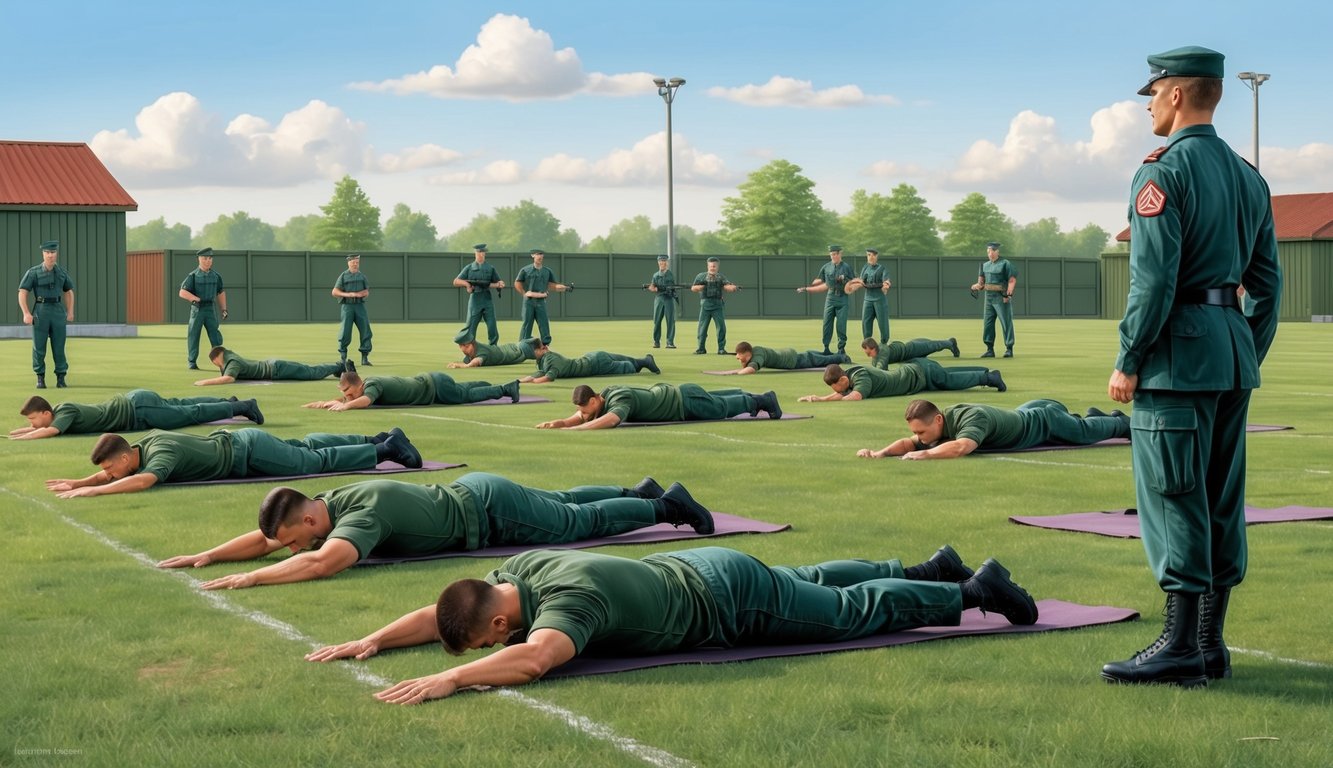Fitness testing and training are vital elements of the United States military.
These stringent evaluations ensure that service members sustain peak physical fitness to fulfill the demands of their duties.
The Army Combat Fitness Test (ACFT) is currently the benchmark, consisting of six events that measure strength, power, speed, and endurance.
The military supplies extensive training manuals to assist soldiers in preparing for these assessments.
These resources feature detailed exercise guidelines, workout schedules, and nutritional advice aimed at enhancing performance in each category.
You’ll encounter exercises such as deadlifts, power throws, and sprint-drag-carry drills that are directly linked to the skills assessed in the ACFT.
Delving into military fitness reveals that it’s not merely about passing a test.
It embodies a lifestyle that fosters overall health, resilience, and readiness.
The training focuses on functional fitness, which boosts performance in both military responsibilities and everyday activities.
Key Insights
- The ACFT assesses soldiers’ strength, power, speed, and endurance through six distinct events
- Military fitness manuals provide customized exercises and nutritional guidance for test preparation
- Military fitness encourages overall health and operational readiness beyond mere test compliance
Comprehending Military Fitness Standards
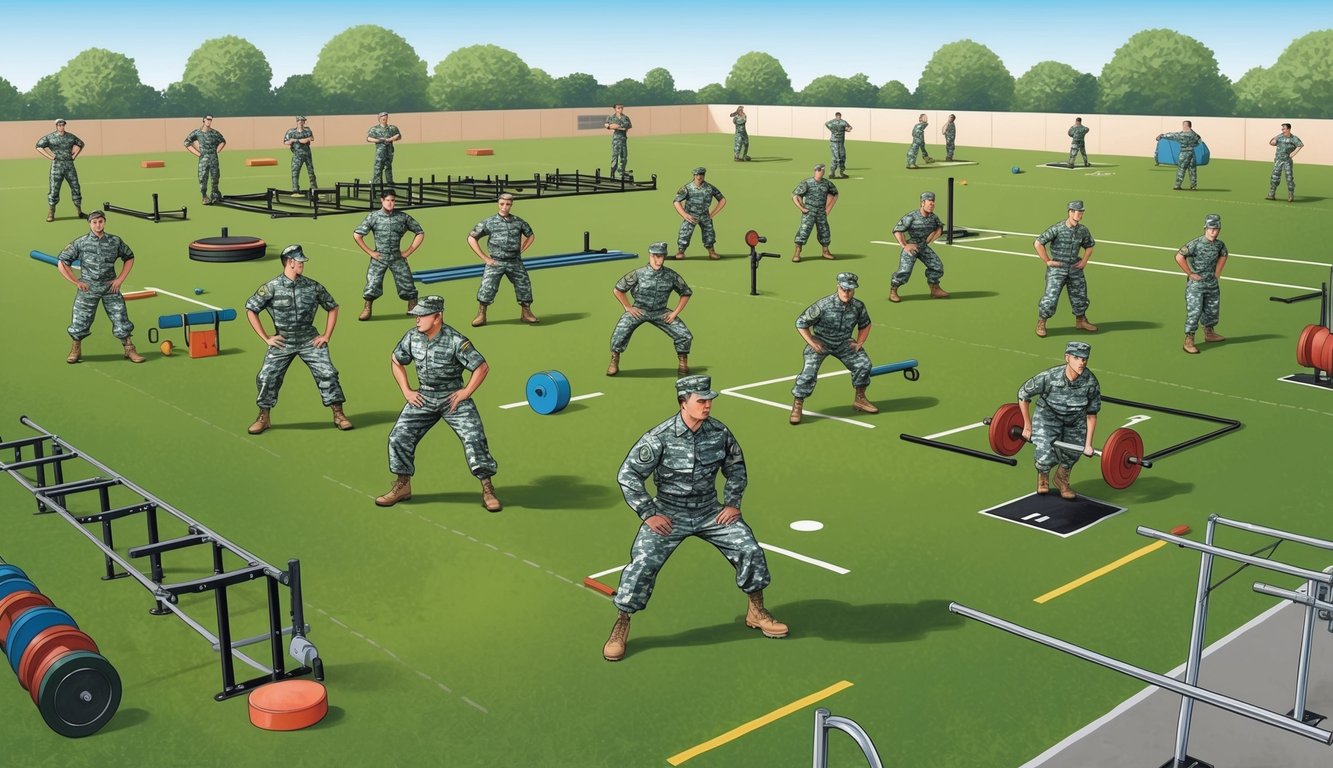
Military fitness standards guarantee that service members are ready for the physical challenges of their roles.
These standards differ among branches and specific positions.
The Objective of Fitness Testing
Fitness testing in the military plays several critical roles.
It gauges your readiness for combat and other essential mission tasks.
Frequent testing encourages you to keep in optimal physical condition throughout the year.
It also highlights areas needing improvement, directing your training focus.
The assessments review vital fitness components:
- Cardiovascular endurance
- Muscular strength
- Muscular endurance
- Power
- Agility
By evaluating these dimensions, the military ensures you can perform effectively under stress and fatigue, contributing to overall unit preparedness and efficacy in various operational settings.
General Physical Fitness Standards
Although specific criteria differ, all branches have baseline fitness requirements.
Generally, you will need to show competence in:
- Push-ups
- Sit-ups or planks
- Running (typically 1.5 to 2 miles)
Some tests, such as the Army Combat Fitness Test (ACFT), include additional components:
- Deadlifts
- Standing power throws
- Sprint-drag-carry exercises
- Leg tucks or planks
Your scores are adjusted by age and gender.
Meeting these criteria often influences career progression and deployment eligibility.
Variations Among Branches and Genders
Distinct military branches have specific fitness requirements tailored to their respective missions.
For instance, the Air Force may prioritize cardiovascular fitness, whereas the Marines focus more on upper body strength.
Gender-specific standards recognize the physiological differences between men and women, ensuring fairness while upholding operational readiness.
In push-up assessments, for instance:
- Men are generally required to complete more repetitions
- Women may have extended time allowances
Age is another consideration.
Older service members often have slightly more lenient standards compared to younger recruits, acknowledging natural variations in physical capacity over time while still demanding a high fitness level across age groups.
Components of Fitness Evaluation
The U.S. military applies a thorough approach to evaluate soldiers’ physical readiness, encompassing diverse fitness dimensions to assure their preparedness for the rigors of combat and military operations.
Evaluating Muscular Strength and Endurance
Muscular strength and endurance are essential for military personnel.
The Army Combat Fitness Test (ACFT) features events like the 3-Repetition Maximum Deadlift to assess lower body and core strength, along with hand-release push-ups to evaluate upper body endurance.
Assessors pay attention to your form and technique during these exercises, counting your repetitions and gauging your ability to maintain proper posture.
The Standing Power Throw event gauges explosive strength where you launch a 10-pound medicine ball as far as possible.
To prepare, include weightlifting and bodyweight exercises in your regimen, focusing on compound movements like squats, deadlifts, and bench presses to enhance overall strength.
Testing Aerobic and Anaerobic Endurance
Your cardiovascular fitness is tested through various events, with the 2-Mile Run being a staple for gauging aerobic endurance.
It’s vital to manage your pace and maintain a consistent rhythm for optimal performance.
Anaerobic capacity is assessed through high-intensity, short-duration activities like the ACFT’s Sprint-Drag-Carry, which combines sprinting, sled drags, and lateral shuffles mimicking combat-related movements.
To enhance your performance, consider these strategies:
- Engage in interval running to improve both aerobic and anaerobic endurance
- Incorporate sled pulls and carries to build specific strength
- Utilize plyometric exercises to boost power and speed
Flexibility, Balance, and Coordination Evaluation
Often overlooked, flexibility, balance, and coordination play vital roles in injury prevention and overall performance.
The Leg Tuck event in the ACFT tests both your core strength and flexibility simultaneously.
Your ability to maintain proper form during dynamic movements will be assessed.
Adequate flexibility enables a full range of motion, while balance and coordination are critical for agility and preventing injuries.
To develop these attributes:
- Practice yoga or dynamic stretching routines
- Incorporate balance exercises such as single-leg stands
- Engage in agility drills to enhance coordination
Fitness Testing Based on Age and Gender
The U.S. military adapts fitness testing to reflect age and gender differences, ensuring fair assessments while upholding high standards across its diverse service members.
Age-Specific Fitness Standards
As you grow older, your fitness requirements in the military evolve.
The Army Combat Fitness Test (ACFT) employs age-normed scoring systems, which establishes different targets based on your age bracket.
For instance, a soldier aged 17-21 may need to lift more weight than someone in their 40s.
The military acknowledges that physical abilities can change as time progresses.
Elder service members still bear the responsibility of maintaining high fitness levels, albeit with adjusted benchmarks.
Gender-Specific Fitness Standards and Opportunities
Gender considerations in fitness testing have been increasingly integrated into military assessments.
Both men and women possess different physiological strengths reflected in these tests.
For example, during push-up evaluations, women generally face differential rep requirements compared to men—this distinction is about equity and recognizing biological differences without diminishing standards.
In the ACFT, both genders have equal opportunities to excel, with the test designed to be pertinent to combat scenarios for all service members.
Service-Specific Fitness Assessments
Each branch of the U.S. military maintains its own fitness standards and assessments, evaluating soldiers’ strength, endurance, and overall combat readiness.
Army Physical Fitness Test (APFT)
The APFT has historically been the Army’s benchmark fitness test, consisting of three components: push-ups, sit-ups, and a two-mile run.
You have two minutes to perform as many push-ups and sit-ups as possible.
Your score is calculated from your performance in each event, adjusting for age and gender.
A perfect score is achievable at 300 points, with 100 points allocated to each event.
The APFT is currently being supplemented by the more comprehensive ACFT, although it remains relevant as some units may still utilize it during the transition phase.
Army Combat Fitness Test (ACFT)
The ACFT serves as the Army’s new fitness benchmark designed to assess combat readiness more effectively.
It comprises six events:
- 3-Repetition Maximum Deadlift
- Standing Power Throw
- Hand-Release Push-ups
- Sprint-Drag-Carry
- Leg Tuck or Plank
- 2-Mile Run
This test encompasses a broader range of physical demands, evaluating muscular strength, power, endurance, and aerobic capacity.
The scoring methodology is gender-neutral, corresponding to your military occupational specialty (MOS).
To excel, focus on functional fitness training that aligns with the test events.
Marine Corps Physical Fitness Test (PFT)
The Marine Corps PFT measures overall fitness through three events:
- Pull-ups or Push-ups (Marines select one)
- Crunches or Plank
- 3-Mile Run
Your score depends on your performance across these events, taking age and gender into account.
A maximum score of 300 points can be achieved, with 100 points available for each event.
Maintenance of steady fitness is crucial, as the PFT typically occurs twice annually, necessitating consistent incorporation of pull-ups, push-ups, core work, and running in your routine.
The Six Components of the ACFT
The Army Combat Fitness Test (ACFT) comprises six rigorous events aimed at evaluating soldiers’ physical preparedness for combat.
Each event targets specific aspects of strength, power, endurance, and agility essential for military effectiveness.
Deadlift
The 3-Repetition Maximum Deadlift evaluates your lower body strength.
You’ll lift a hex bar loaded with weights from a resting position.
Begin with feet shoulder-width apart while gripping the handles.
Raise the bar by extending your hips and knees, keeping your back straight.
Lower the weights with control.
You have three chances to lift the maximum weight achievable for three repetitions.
This challenge simulates actions like carrying injured soldiers and heavy gear.
Standing Power Throw
This event evaluates explosive power.
You’ll throw a 10-pound medicine ball backward over your head as far as possible.
Set your back to the target, gripping the ball with both hands.
Squat down and explosively rise up to throw the ball aloft.
You’ll get two practice throws and three official attempts, with your longest throw counted.
This mimics tasks such as loading equipment or climbing walls.
Hand-Release Push-Up
Hand-release push-ups assess upper body muscular endurance.
Start in a standard push-up stance, lowering your body until your chest touches the ground.
Briefly lift your hands off the floor, then return to the starting position.
This counts as one repetition.
You have two minutes to complete as many reps as possible—relevant to tasks like pushing obstacles or moving dynamically in combat environments.
Sprint-Drag-Carry
This event tests anaerobic capacity and overall body strength through five 50-meter shuttles performing various tasks:
- Sprint
- Drag a 90-pound sled
- Lateral shuffle
- Carry two 40-pound kettlebells
- Sprint again
Complete these in succession as quickly as possible, simulating maneuvers under fire, casualty recovery, and ammunition transport.
Leg Tuck
Leg tucks evaluate your core strength and grip endurance.
Hang from a pull-up bar with arms fully extended.
Lift your knees to touch your elbows, then lower them back down—this equals one repetition.
Perform as many leg tucks as you can without a time limit, avoiding any resting on the ground in between reps.
This event mirrors climbing and navigating obstacles.
Two-Mile Run
The two-mile run gauges your aerobic endurance as the final component of the ACFT.
You’ll run on a measured distance, aiming for the fastest completion time.
Manage your pace while maintaining a consistent rhythm.
This event models the sustained cardiovascular demands encountered during combat operations.
Preparing for Military Fitness Assessments
Success in military fitness assessments demands thorough preparation.
An effective strategy integrates structured training, persistent effort, alongside proper nutrition and recovery tactics.
Structured Training Approaches
Initiate your preparation with a dedicated training regimen, aiming for 4-5 workouts weekly that focus on the specific fitness components of your assessments.
Incorporate cardiovascular activities such as running, cycling, or swimming for endurance building.
Include strength training with bodyweight and weightlifting exercises.
Regularly practice test events.
If required to do push-ups, pull-ups, or sit-ups, frequently incorporate these into your workout.
Gradually increase repetitions while reducing rest intervals between sets.
Interval training should be considered to enhance speed and recovery.
Engage in sprint workouts or high-intensity circuits.
Maintaining a training log can be highly beneficial for tracking progress and sustaining motivation.
The Significance of Consistency and Progression
Consistency is critical during fitness preparation.
Commit to your training regimen, even on days when motivation wanes.
Start at an attainable level and progressively increase intensity.
Add weights, repetitions, or duration to workouts as they grow easier.
Establish incremental, realistic goals throughout your training and celebrate achievements to maintain enthusiasm.
Always prioritize proper form to sidestep injuries and ensure effective training.
Rest days are equally essential for recovery and preventing overall burnout.
Nutrition and Recovery Tactics
Support your training with a well-balanced diet that includes ample lean protein, complex carbohydrates, and healthy fats.
Stay adequately hydrated by drinking water throughout the day, not only during workouts.
Prioritize sufficient sleep, targeting 7-9 hours each night to aid muscle recovery and overall wellness.
Consider recovery snacks or protein supplements after high-intensity workouts.
Engage in foam rolling and stretching practices to mitigate soreness and boost flexibility.
Pay attention to your body; if you experience pain or extreme fatigue, allow yourself an additional rest day.
Utilize meditation or deep breathing techniques to manage stress, as it can significantly impact physical performance.
Best Practices for Enhancing Fitness
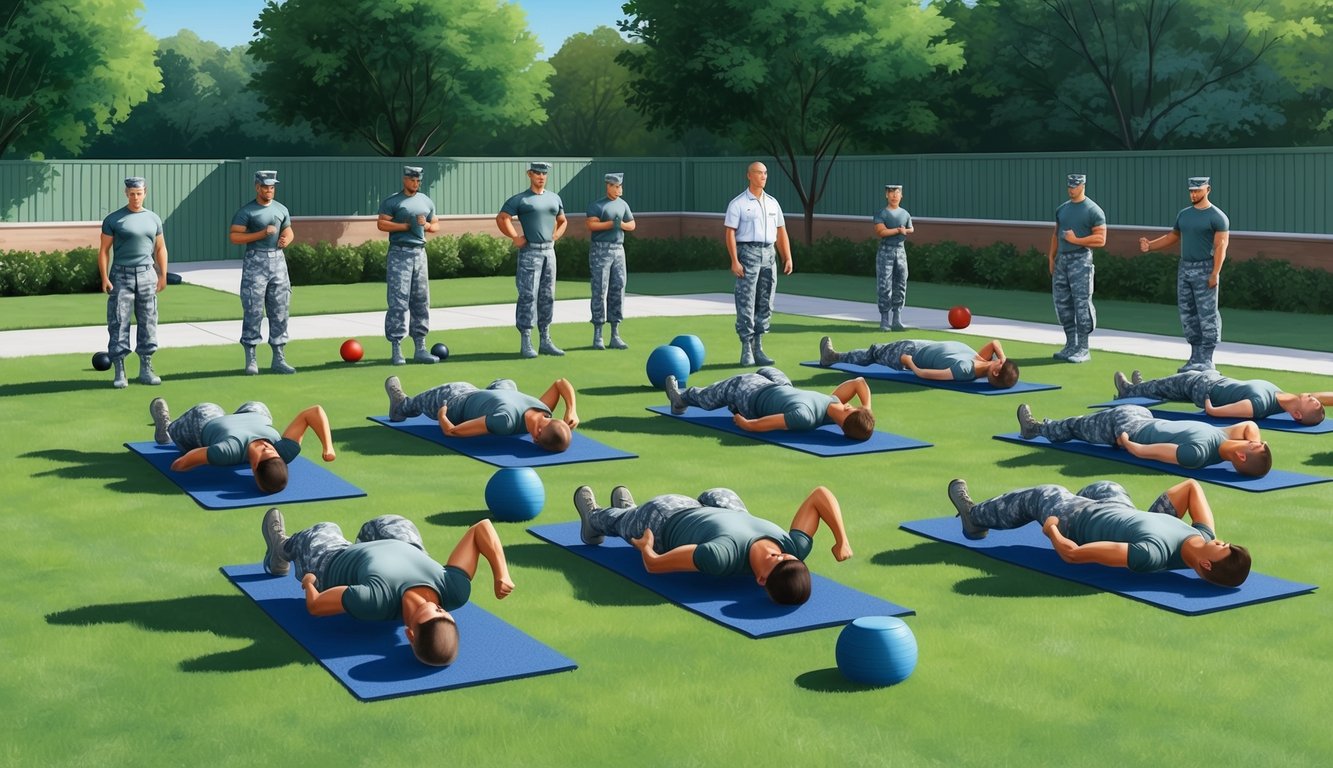
Maximizing your military fitness requires an approach that goes beyond just physical training.
Emphasizing safety, taking a comprehensive approach, and fostering mental resilience are essential components of success.
Injury Prevention and Safety
Ensure correct form and technique during workouts to prevent injuries.
Begin each session with a thorough warm-up and conclude with a cool-down to prepare your body.
Gradually increase the volume and intensity of workouts to avoid overtraining.
Listen to your body and take necessary rest days.
Wearing appropriate footwear and safety gear can minimize injury risk.
Integrate rest days and active recovery into your training calendar, allowing your body to heal and strengthen.
Seek immediate medical assistance for persistent discomfort.
A Comprehensive Approach to Health
Fitness encompasses more than just physical exercises.
Aim for quality sleep, targeting a minimum of 7-9 hours nightly.
Good rest supports recovery, cognitive clarity, and enhanced performance.
Adopt a balanced diet rich in lean proteins, complex carbohydrates, and healthy fats.
Proper nutrition fuels workouts and aids muscle restoration.
Manage stress through relaxation practices such as meditation or breathing exercises, which can elevate your mental well-being and physical recovery.
Routine health check-ups allow for early detection of potential health issues.
Stay current with vaccinations and preventative healthcare measures to sustain optimal health.
Cultivating Mental Resilience
Build a positive mentality through goal-setting and visualization tactics.
Break larger ambitions into smaller, manageable milestones to boost confidence.
Practice mindfulness techniques to enhance focus and decrease anxiety in high-pressure situations, aiding performance.
Participate in team-building exercises to strengthen camaraderie and mutual encouragement, bolstering your resilience and motivation.
Regularly challenge yourself with new exercises or increased intensity.
Overcoming these obstacles promotes mental fortitude and adaptability.
Embrace discomfort during training as preparation for real-world scenarios; this mental conditioning will be invaluable during intense military situations.
Minimum Service Standards and Scoring
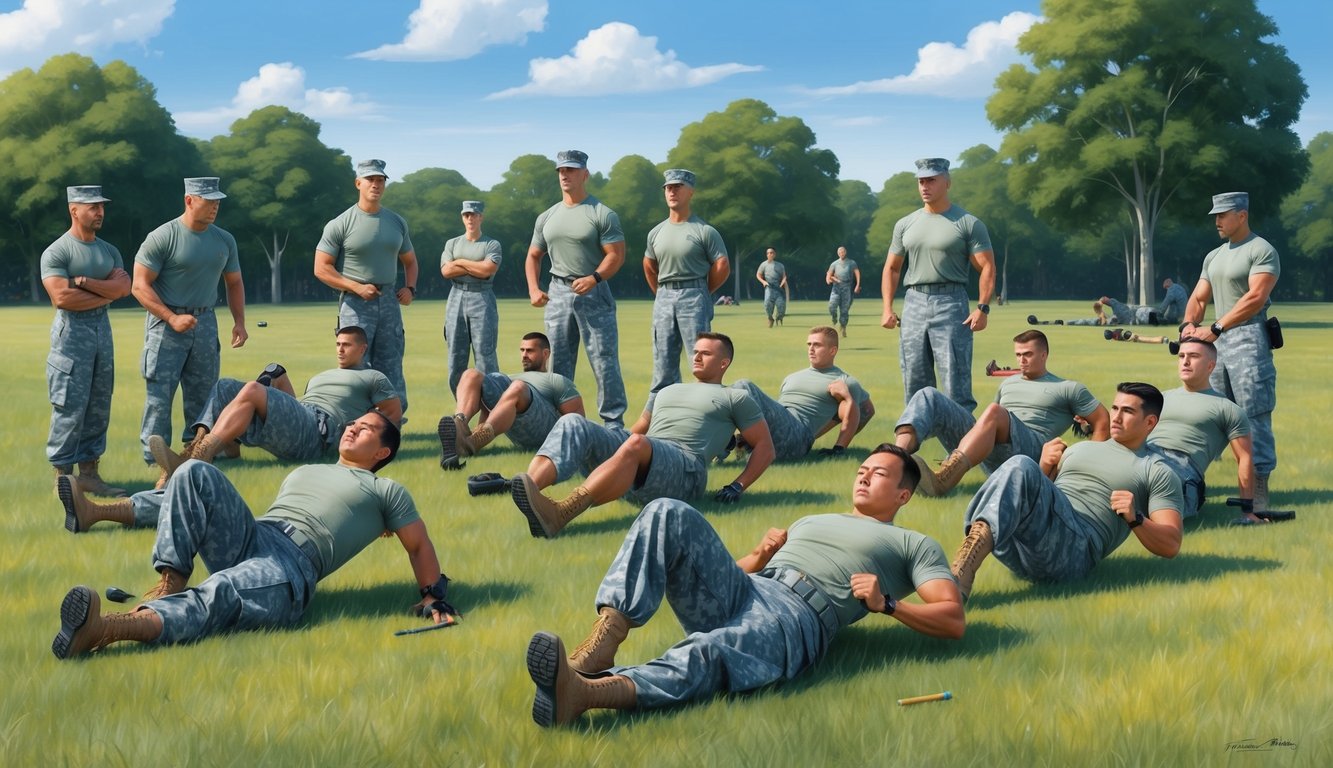
The Army Combat Fitness Test (ACFT) employs a point-based evaluation system to assess soldiers’ physical readiness.
Understanding the scoring metrics and minimum thresholds is vital for success in your military career.
Grasping the Scoring Framework
The ACFT scoring system ranges from 0 to 600 points, with up to 100 points awarded for each of the six events.
Events encompass the deadlift, standing power throw, hand-release push-ups, sprint-drag-carry, plank, and two-mile run.
Your performance in each event corresponds to specific benchmarks.
For example, lifting 340 pounds in the deadlift may yield 100 points, while 140 pounds could result in 60 points.
A calculator can assist in determining your score based on your event performance, serving as a useful tool for tracking progress and pinpointing areas needing improvement.
Minimum Passing Criteria
To pass the ACFT, it is necessary to score at least 60 points in each event, meeting the minimum standards across all six test components.
For instance, holding a plank for roughly 2 minutes and 9 seconds might secure the minimum 60 points.
Completing the two-mile run in 21 minutes or less would also meet the standard.
Falling below 60 points in any event results in an overall test failure, emphasizing the need for consistent training to achieve these baseline requirements.
Surpassing Standards for Career Progression
While meeting minimum standards is imperative, exceeding them may enhance your career prospects.
Scores are classified as poor, fair, good, excellent, or outstanding.
Achieving an excellent score (around 80 points per event) or higher can distinguish you from your peers, showcasing a superior level of physical preparedness and commitment to fitness.
For example, completing 30 hand-release push-ups in two minutes might yield an excellent score.
Running two miles in 13:30 or less could also qualify you in the excellent category.
Consistently outperforming standards can favorably influence evaluations, promotions, and special assignment opportunities, acting as a demonstrative measure of your dedication and capabilities.
Challenges Beyond the Fundamentals
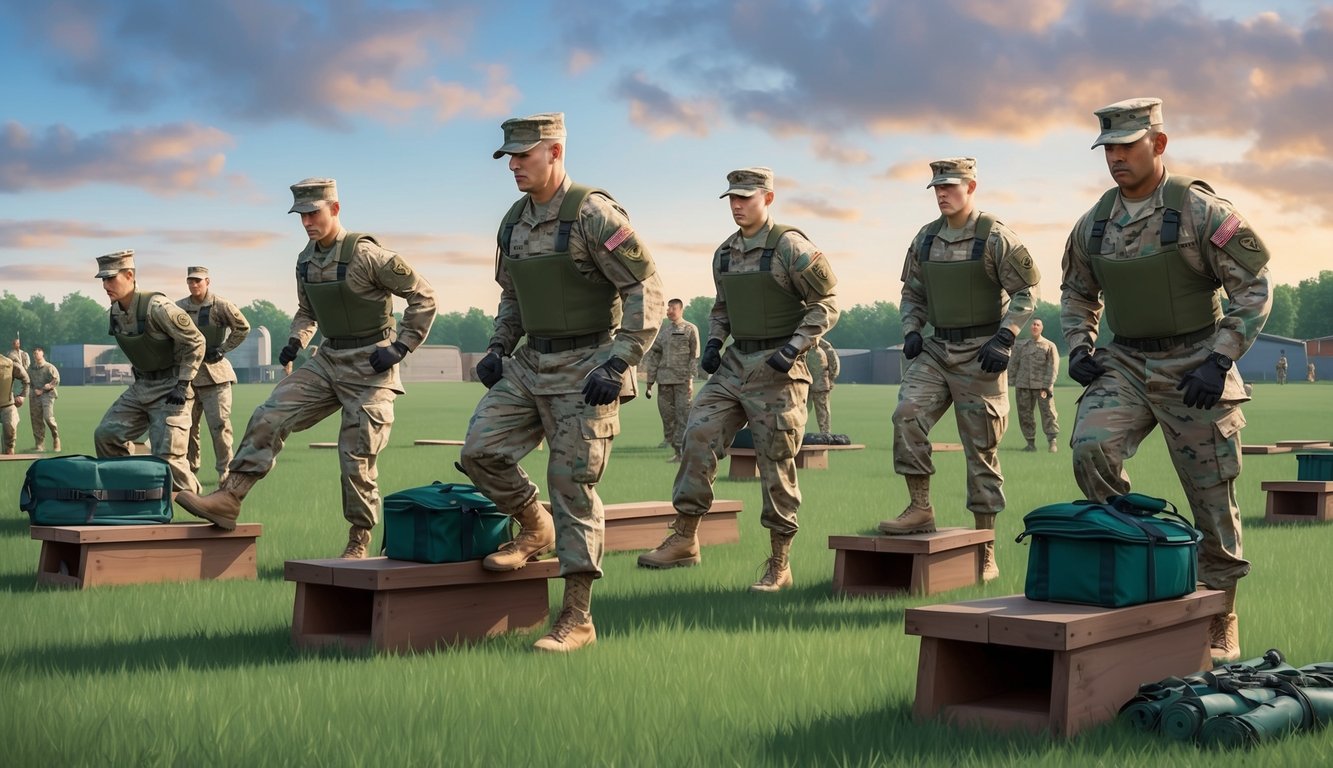
Military fitness involves challenges that far exceed standard assessments, requiring specialized training and mental toughness.
Training for Specialized Military Roles
Different military occupational specialties (MOS) have unique fitness demands.
Snipers require outstanding core stamina and stability for extended durations, whereas Special Forces roles demand exceptional endurance and upper body power for intense missions.
Combat medics must possess the ability to carry heavy equipment and injured peers, necessitating targeted training in load-bearing exercises and functional movements.
For aviation roles, strengthening the neck and core is crucial to endure high G-forces, with specialized tools like inversion tables aiding such preparations.
Cross-training in activities such as rock climbing or swimming enhances overall fitness while building skills relevant to various military specialties.
Advancing through Rigorous Training Programs
Elite military programs challenge you to your utmost limits.
Navy SEAL training involves “Hell Week,” characterized by almost continuous physical effort and minimal sleep, necessitating robust mental resilience alongside physical readiness.
The Army Ranger School evaluates your capacity to perform under extreme fatigue and stress.
Concentrate on cultivating a solid aerobic base and muscular endurance to excel during prolonged ruck marches with heavy loads.
To succeed in these rigorous programs, remember to:
- Train under all weather conditions
- Safely practice sleep deprivation
- Engage in team-oriented workouts
- Push beyond your comfort zones regularly
The mind often abandons the effort before the body does.
Therefore, cultivating mental toughness is just as imperative as physical conditioning.
Achieving Endurance and Tactical Fitness
Modern combat scenarios call for a unique combination of endurance and explosive strength.
You should possess stamina for extended missions and quick responsiveness for sudden combat situations.
Incorporate interval training to build anaerobic capabilities by mixing sprints with bodyweight exercises like burpees or mountain climbers.
Ruck marches are critical for developing military-specific endurance; begin with lighter loads before progressively increasing weight and distance.
Tactical fitness includes performing efficient movements while equipped.
Practice exercises like bear crawls, low crawls, and buddy carries while in full gear.
Enhance grip strength for effective weapon control and navigation through obstacle courses by utilizing thick bars, towels, and farmer’s walks in training.
Always balance intense workouts with adequate recovery strategies, as quality sleep and nutrition are vital for maintaining optimal military fitness.
Military Fitness Culture and Support

A robust fitness culture alongside a supportive network is essential for military readiness, providing dedicated professionals and resources to maintain peak physical performance throughout your service.
The Importance of a Fitness Culture in the Military
The fitness culture within the military transcends merely clearing tests; it embodies a lifestyle of health and preparedness.
Within this environment, physical fitness is regarded as a foundational aspect of military service.
Group workouts foster camaraderie and motivation among service members, as peers and leaders inspire one another to continuously enhance their performance.
Many bases provide state-of-the-art gyms and fitness facilities, allowing access to equipment and classes that support individual training aspirations.
The culture prioritizes functional fitness connected to combat preparedness, centering on exercises that translate effectively into military operations.
Support Roles: Nutritionists, Trainers, and Mental Health Professionals
A team of professional resources is available to bolster your fitness journey.
Registered dietitians guide you in crafting meal plans that align with your training goals and desired body composition.
Master fitness trainers can develop tailored workout programs and coach you on proper techniques and form, maximizing results while minimizing injury risks.
Mental health counselors assist in managing the psychological aspects of fitness, helping to navigate obstacles, stress, and maintain motivation.
Support throughout your journey is accessible, from recruitment stages to retirement.
Recruiters often provide an early start with fitness preparation initiatives before enlistment.
This collaborative professional network is committed to ensuring you’re always operating at your best.
Don’t hesitate to leverage these resources throughout your military career.
Fitness Evaluations and Entry Programs
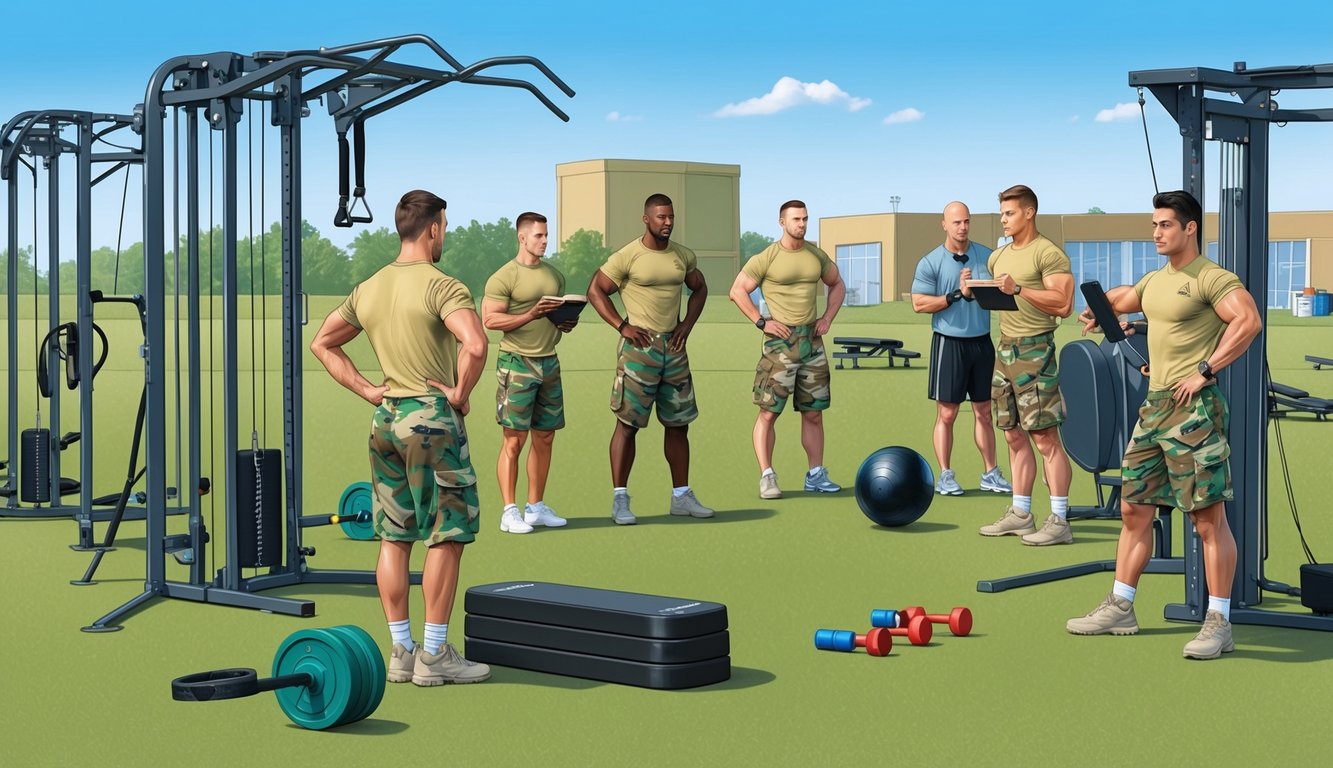
Enlisting in the U.S. military necessitates adherence to specific fitness criteria and undergoing assessments, ensuring recruits are poised for the physical demands of service.
Delayed Entry Program and Fitness Expectations
The Delayed Entry Program (DEP) allows potential recruits to enlist in the military before their scheduled date for basic training.
During this waiting period, maintaining and improving your fitness is expected, with guidance provided on physical training and nutrition.
The Army, Navy, Air Force, and Marines have unique fitness standards; for the Army, the completion of the Army Combat Fitness Test (ACFT) is required, including components such as deadlifts, power throws, and push-ups.
For achieving success in the DEP, you should:
- Set realistic fitness objectives
- Follow provided exercise plans
- Track your development
- Attend DEP meetings for camaraderie and support
Fitness Evaluation at Basic Training
Upon entering basic training, you will undergo a preliminary fitness assessment to gauge your current physical condition, allowing instructors to tailor training to your needs.
This assessment generally comprises push-ups, sit-ups, and a 1.5 or 2-mile run.
Your performance will determine your subsequent fitness grouping.
Don’t be disheartened if initial results seem challenging—the training program is structured to progressively enhance your strength and endurance.
To graduate, you must meet the minimum fitness standards set for your branch of the service, ensuring readiness for the physical challenges ahead.
Common Questions
The process surrounding U.S. military fitness assessments can appear intricate.
Below are responses to frequently asked queries regarding preparation for and success in these evaluations.
How can I adequately prepare for the U.S. military fitness test?
Begin by emphasizing both cardiovascular and strength training, with regular running sessions to build endurance for the 2-mile run.
Focus on push-ups, sit-ups, and pull-ups to enhance upper body and core strength.
Ensure you practice specific test events, such as the standing power throw and deadlift, to be effective during the assessment.
Progressively raise workout intensity, with a goal of at least 30 minutes of exercise five times a week, and remember to include recovery days.
What exercises are part of the Army Physical Fitness Test (APFT)?
The APFT consists of three events: push-ups, sit-ups, and a 2-mile run.
You’ll have 2 minutes to complete the maximum number of push-ups and sit-ups, followed by a brief interlude before the 2-mile run.
Be aware that the Army is currently transitioning to the new Army Combat Fitness Test (ACFT), which contains six events.
What is the minimum passing score for the Army’s ACFT?
The minimum passing score for the ACFT varies with military occupational specialty (MOS).
Most soldiers require at least 60 points in every event to pass.
Scoring is designed to be age and gender-neutral, while specific combat-intensive roles might necessitate higher scores.
Can you outline the 16-week military training program for new recruits?
Basic Combat Training (BCT) spans 10 weeks, followed by Advanced Individual Training (AIT).
BCT focuses on physical conditioning, weapon skills, and fundamental tactics.
You will begin with lighter workouts, gradually advancing to more intense regimens.
Daily routines typically encompass runs, strength training, and obstacle courses.
The program also incorporates academic instruction on military principles and operations.
What are the physical requirements for the 2-mile run in the Army fitness test?
For the ACFT, the 2-mile run is timed, and passing benchmarks differ based on age and gender.
For example, male soldiers aged 17-21 must finish the run within 21:00 minutes for a minimum score.
To excel, strive for faster completion times; a max score for this age group is achieved by completing the run in 13:30 or less.
Where can I access a free military workout program for download?
The U.S. Army provides free resources via their official website, featuring training guides and workouts focused on ACFT preparation.
Additionally, various military fitness applications are available for free, frequently including exercise demonstrations and tracking functionalities to assist you in monitoring your progress.

